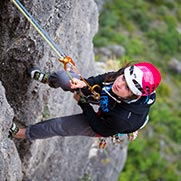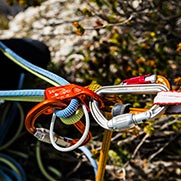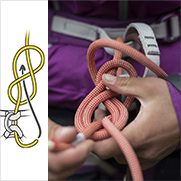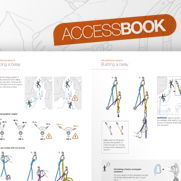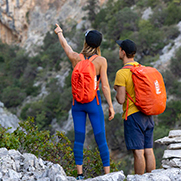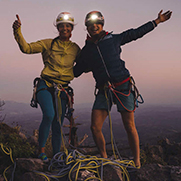Motivation, Training, and Projecting with Tim Emmett
Tim Emmett is a rock climber, ice climber, mountaineer, father, free diver, and general all-around crusher. In this interview he shares his tips for performance, longevity, and stoke. Enjoy!
July 11 2023
Indoor and Outdoor Climbing
@Anghelo Bernal
What is it about being an all-around climber that’s so important to you?
Well it’s never boring! You’ve always got something new to focus on. Leaving Spain this year without doing Era Vella would hurt a lot more if I didn’t have something else to look forward to.
But now I’m back home training for steep ice climbing at Helmcken Falls. And you’ve got to train for Helmcken Falls. It’s so hard, it’s so demanding. You have to show up already physically prepared.
You've climbed hard gritstone trad, steep ice climbing, and hard sport routes. How do juggle all of these different disciplines?
Well the answer is seasons. I move with the seasons. In the spring when the sun comes out and the rain stops, rock climbing is the obvious choice. In the summer, it gets really hot out so you go up to the mountains, look at mountaineering goals. In the fall, the temps are good and you try to send your project, whether that be sport climbing or trad climbing. And then winter rolls around and you’re back to ice climbing!
For me, I’ll have a goal. I’ll focus on that goal, train for that goal, and then finish that chapter and focus on something else.
Right now, I’m training for ice season, training for steep ice and Helmcken Falls, but I really want to maintain my specific sport climbing fitness for Era Vella. I am trying to dial in a more scientific approach to training for Era Vella.
So right now I’m working on this program where I start every training session working on my fingers, for rock climbing specific power and endurance. When my fingers get tired I move onto my tools and train for ice climbing and winter climbing. This means my training sessions can be like 4-5 hours.
@MikeRobertson/mikerobertsonphotography.com
Has training so hard always been a part of your climbing? What has made you want to train so hard?
I now understand what effective training looks like, for me. That's helped me to do is pass that information on to other people. I think that this last trip, I shared a lot of my personal journey with the route, and people really connected with it.
I’ve had so many messages with people who are like, “seeing what you’re doing and what you’re going through has really helped me”. That’s something that I don’t think I’ve ever been able to do something like that before and it’s given a whole new importance to the process of doing this route. It’s more meaningful than I ever thought it could be. It’s no longer just a selfish process.
Why did you choose this route Era Vella?
First of all, the reason I want to keep going back to Era Vella is because I want to know what its like to get to the top. And I know that’s really selfish, but I’ve invested so much time physically and mentally. When Angelo climbed it and I was belaying him, and I just totally burst into tears. I think part of it was I was so happy for him, but part of it also was that I wanted to be in his shoes, having done the route.
If that’s what I feel like belaying someone on the route, I can’t imagine what it would feel like to clip the chains. I never thought I could connect with sport climbing in this way, I never imagined it would affect me emotionally like it has, but I have an emotional connection to this route.
I’ve focused climbing on ice climbing and base jumping and trad climbing and I always kind of thought of sport climbing as ‘whatever’ but it’s brought out a whole new emotional experience.
Era Vella has taken me on a journey to be a better climber than I ever thought I could be. Everytime I come back after failing on the route, I’ve shifted my training to stack the deck in my favor so that when I go back the next time, I’m more prepared. And this process has made me a better climber than I ever thought I could be.
@MikeRobertson/mikerobertsonphotography.com
What are some key takeaways that you would like to share with people who want to start training or do some hard projects of their own?
Oh, I’ve learned so much!
Some of the key takeaways:
- With a plan, with some discipline, and with an attitude where you’re willing to make sacrifices — you can transform your body way more than you think you can
- Consistency: make sure you have a plan, and make sure you’re disciplined
- Make sure to record your training — it’s so motivating to see your numbers go up
- Don’t be afraid of failure — embrace the fact that you might fail
- If you only want to win all the time and just succeed — you’re not really focusing on what you’re doing.
Some other things i’ve learned, is how to REALLY focus on the moment. You’re not focusing on the top and you’re not focusing on the crux, your focusing on the move that you’re on. And then the next one. And that’s it. So whether you’re using breathing techniques. You notice that if you’ve got a lot of internal dialogue, if you’ve got any internal dialogue, and you want to turn it off: try dropping your tongue. It will send a signal to your brain to drop the internal dialogue and allow you to focus on the move or the hold that you’re on, thinking about how the hold feels against your fingertips, and feeling the wind in your air, and being really present in the moment is a great way of accessing flow state. And usually getting into flow state is the way to succeed.
And to get into flow state you’ve got to switch off your internal dialogue. So you’re not thinking about falling off, or thinking about the moves. You don’t want to be thinking up there.
All those extraneous thoughts are just distracting you from what you’re doing. So if you can not think, and be present in the moment.
Breathing is sooo important. I picked it up from freediving. When we’re teaching people how to free dive, and when you come up for air, you do this thing called a recovery breath. It’s a technique designed to get as much oxygen into your lungs as possible. And I was like, “wow, if I did that when I’m climbing, surely that’s gonna help me’. When people breathe hard, they breathe in and breathe out, and focus so much on exhaling. And what you really want to be doing is breathing in harder than you’re breathing out. To reduce the air pressure in your lungs. If you really focus on breathing in, it’s different and you can get a lot more air.
Oh yea, the last thing I have is, one of the things i noticed that it doesn’t matter at all how I felt before I started climbing. There would be days where I was warming up and I would be like, “oh man, i am gonna do this, for sure’. And I would stand at the bottom of the route and I would start climbing and i would feel amazing, and then I’d still fall off. But the the third go of the day when I’m totally knackered, and I don’t think there’s any reason that I should try, I would get a new highpoint. For anybody out there, all the stuff going on in your head before you start climbing, it doesn’t matter.
Get rid of it!
Focus on the moves and get rid of your thoughts.
When you say ‘get rid of it’? How do you do to do that?
So what I do, I have this reset.
I shut my eyes, because it reduces a lot of stimulation. Take three deep breaths. In and out. And then I open my eyes and I climb. Relax your shoulders, let go of tension. And go. That’s a really great technique for resetting. Or put some headphones on, take a walk and listen to one of your favorite tracks, and really enjoy the music. That can change your state really effectively.
The last one is: create a metaphor and climb like that metaphor. So ask yourself: when i’m climbing well, what am I climbing like? Say to yourself, I am ______. Whatever you want it to be.
Rather than thinking can I do, it are the conditions bad, my skin hurts, just have a mantra and repeat it to yourself.
You have to find the metaphor that works for you. But this mantra and metaphor helps distract you from your internal dialogue. And then you do the route!
Included in this article
Related News


